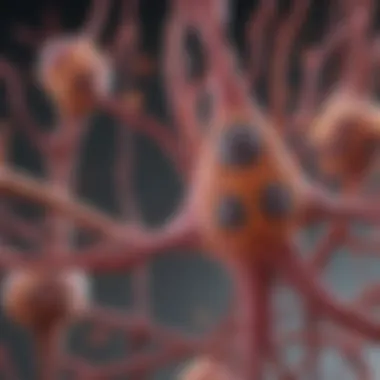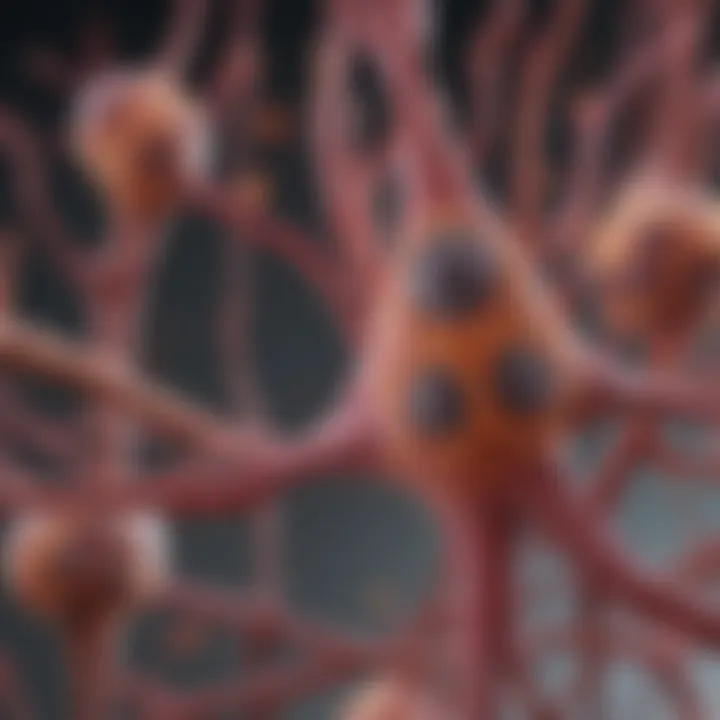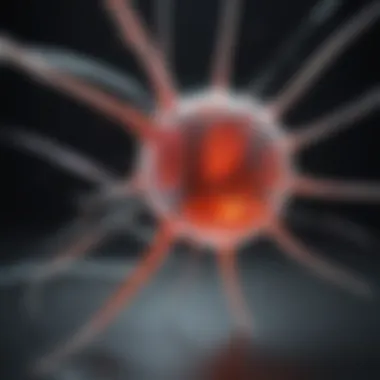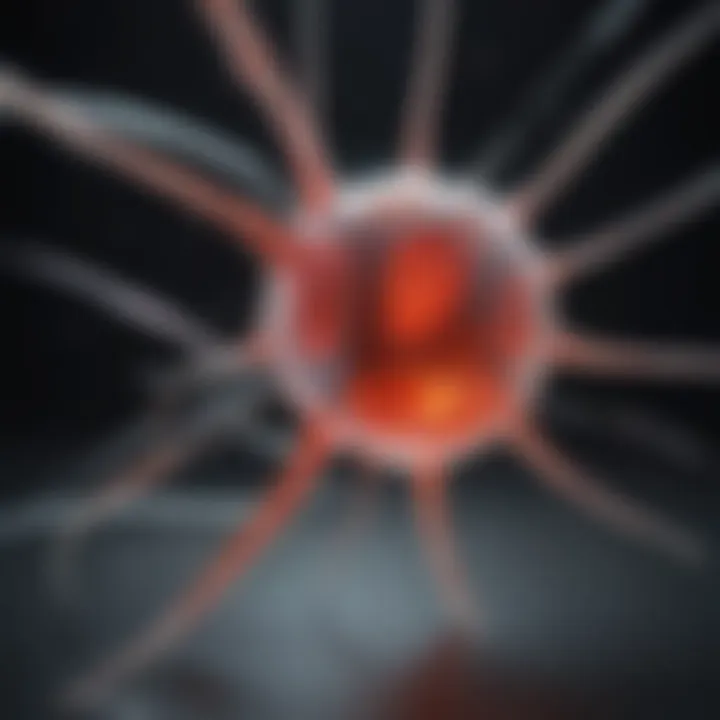Human Bone Marrow Stem Cell Conditioned Media Insights


Intro
Human bone marrow stem cell conditioned media (BMSCCM) holds significant promise in the realm of regenerative medicine. This article aims to elucidate the therapeutic implications and applications of BMSCCM, providing clarity on its mechanisms of action, composition, and potential uses in medical practices. By focusing on the diverse roles that conditioned media play, we can better understand how it influences healing processes and treatment modalities in both clinical and research settings.
Research Overview
The exploration of BMSCCM is increasingly relevant for professionals in regenerative medicine, highlighting its multifaceted benefits in therapeutic applications. This section will offer a synthesis of key findings that have emerged from recent studies alongside an insight into the methodologies that underpin this research.
Key Findings
- Healing Properties: Multiple studies demonstrate the ability of BMSCCM to enhance wound healing and tissue regeneration. Key bioactive molecules within the media, such as growth factors, play a crucial role in promoting cellular proliferation and differentiation.
- Anti-Inflammatory Effects: The conditioned media exhibits anti-inflammatory properties, which can be beneficial in treating chronic inflammatory diseases. This effect stems from the release of various cytokines and chemokines that modulate immune responses.
- Cellular Communication: BMSCCM facilitates intercellular communication, which is essential for coordinating tissue repair processes. Extracellular vesicles in the media are implicated in transferring molecular signals between stem cells and target tissues.
Study Methodology
The research on BMSCCM often utilizes a combination of in vitro and in vivo methodologies. In vitro studies help determine the composition of BMSCCM and its effects on various cell types, while in vivo studies often assess regenerative outcomes in appropriate animal models. Among the common techniques employed:
- Cytometric Analysis: To quantify and characterize secreted proteins and factors within the conditioned media.
- Gene Expression Studies: To evaluate the changes in gene expression in response to BMSCCM treatment.
- Repair Models: Utilizing animal models for wound healing or tissue injury to analyze the efficacy of BMSCCM.
Understanding these methodologies is vital for interpreting the reported outcomes of the studies and their implications for human applications.
Background and Context
Historical Background
The field of regenerative medicine has evolved significantly over the last few decades. Initially rooted in basic biological research, it has expanded into practical applications in clinical settings. The concept of using stem cells for healing dates back to the discovery of hematopoietic stem cells in the bone marrow. Conditioned media emerged as a pivotal byproduct that carries numerous therapeutic potentials in regenerative processes.
Current Trends in the Field
Presently, there is a growing interest in applying BMSCCM across various areas of medicine. Researchers focus on diverse applications ranging from orthopedic repairs to treating cardiovascular diseases. New technologies have accelerated the investigation of stem cell-derived factors, making BMSCCM a focal point of regenerative discussions. Areas of interest include:
- Tissue Engineering: Utilizing BMSCCM to enhance scaffolds in creating functional tissues.
- Chronic Disease Management: Exploring the use of conditioned media in treating diseases such as diabetes and arthritis.
- Personalized Medicine: Developing tailored therapies based on the unique composition of an individual’s BMSCCM.
The exploration of human bone marrow stem cell conditioned media has become a cornerstone in future regenerative medical therapies, pushing the boundaries of what is possible in healing and recovery.
By establishing this foundational understanding, we can delve deeper into the specifics of BMSCCM and its promising applications in regenerative medicine.
Prologue to Bone Marrow Stem Cells
Bone marrow stem cells are essential to the understanding of regenerative medicine. They offer a unique capability to differentiate into various cell types, thus playing a vital role in healing and tissue repair. This section highlights the significance of bone marrow stem cells, focusing on their characteristics and potential applications.
Understanding Stem Cells
Stem cells are undifferentiated cells that have the remarkable ability to develop into specialized cell types. Their capacity to self-renew and differentiate makes them a critical resource in medical research and treatments. Bone marrow stem cells, specifically, are known for their role in producing blood cells, including red blood cells, white blood cells, and platelets. They are often categorized into two main types: hematopoietic stem cells and stromal stem cells.
Hematopoietic stem cells primarily give rise to blood cells, while stromal stem cells contribute to the supportive tissues in the bone marrow. This dual functionality highlights the importance of bone marrow stem cells in both hematopoiesis and the maintenance of the bone marrow microenvironment.
Characteristics of Bone Marrow Stem Cells
Bone marrow stem cells possess several key characteristics that set them apart from other cell types:
- Multipotency: They can differentiate into multiple cell lineages, which makes them highly valuable for therapeutic purposes.
- Self-renewal: They have the ability to undergo several cycles of cell division while maintaining their undifferentiated state.
- Niche Interaction: Bone marrow stem cells interact with their microenvironment, or niche, which regulates their behavior, proliferation, and differentiation. This interaction is crucial for their function and longevity.
Furthermore, clinical and experimental research continues to uncover new insights about these cells. For instance, the ability of bone marrow stem cells to secrete various cytokines and growth factors can adapt their therapeutic potential. They can modulate the immune response and facilitate tissue repair, making them pivotal in regenerative therapies.
Defining Conditioned Media


Conditioned media is a critical topic in understanding the wider applications of human bone marrow stem cells. It acts as a bridge between basic research and clinical applications. By extracting specific factors produced by stem cells, conditioned media contains a wealth of information and potential therapeutic agents. This section clarifies what conditioned media is and delves into its components, which are crucial for exploring its role in regenerative medicine.
What is Conditioned Media?
Conditioned media refers to the fluid collected from cell cultures after we expose the cells to specific conditions. This fluid contains secreted factors from the cells that can influence the behavior of other cells. In the case of bone marrow stem cells, their conditioned media encompasses a diverse set of biologically active molecules, such as growth factors, cytokines, and extracellular vesicles. These molecules play a significant role in cell signaling and tissue regeneration.
Researchers use conditioned media for various purposes, including understanding cellular interactions, identifying therapeutic targets, and testing drug effects in vitro. The use of conditioned media eliminates the potential need to use whole cells in preliminary stages of research, allowing for focused studies on soluble factors.
Components of Conditioned Media
The effectiveness of conditioned media in therapeutic contexts greatly relies on its components. It typically contains:
- Growth Factors: These proteins stimulate cell proliferation, differentiation, and survival. Common examples are vascular endothelial growth factor (VEGF) and fibroblast growth factor (FGF).
- Cytokines: These are small signaling proteins that facilitate communication between cells. They can modulate various immune responses and influence inflammation.
- Proteins and Enzymes: Various enzymes and proteins in conditioned media play essential roles in tissue remodeling and repair.
- Extracellular Vesicles: These carry genetic material and proteins, mediating intercellular communication and influencing target cell behavior.
Understanding these components helps researchers manipulate conditioned media for specific therapeutic outcomes, thus maximizing its potential in regenerative medicine.
“Conditioned media reflects the in vivo environment of stem cells and serves as a valuable tool for therapeutic strategy development.”
Mechanisms of Action of Conditioned Media
Understanding the mechanisms through which human bone marrow stem cell conditioned media operates is crucial for grasping its implications in various therapeutic contexts. Conditioned media is not just a byproduct; it reflects the complex interactions and signals that stem cells employ to communicate and exert their effects on other cells. The study of these mechanisms reveals the potential benefits and considerations necessary for advancing regenerative medicine initiatives.
Signaling Pathways Involved
The intricacies of signaling pathways involved in conditioned media are fundamental. These pathways govern how stem cells communicate with their environment and with other cells. Key pathways include the Wnt/β-catenin, Notch, and Hedgehog signaling pathways. These processes are vital for coordinating cellular responses and facilitating tissue repair. For instance, the activation of the Wnt pathway can promote cellular proliferation and differentiation, while Notch signaling plays an essential role in maintaining stem cell populations.
Researchers emphasize the importance of understanding how these pathways interact with each other. This interaction can lead to different outcomes depending on the cellular context. By decoding these signals, scientists hope to harness the benefits for therapeutic applications in tissue engineering and regenerative medicine. Knowledge about the specific signals released by bone marrow stem cells informs optimal strategies for their application.
Role in Cellular Communication
The role of conditioned media in cellular communication is significant. When stem cells release various factors into the surrounding media, they create a biochemical environment that can dictate the behavior of adjacent cells. This communication can be autocrine, paracrine, or endocrine, depending on the distance between the signaling cells and the target cells.
Important aspects include:
- Cytokines: These small proteins are critical in immune responses and tissue repair.
- Growth factors: They stimulate cell growth, proliferation, and differentiation. Examples include Transforming Growth Factor Beta (TGF-β) and Vascular Endothelial Growth Factor (VEGF).
- Exosomes: These vesicles play a role in the transport of proteins and genetic material, providing a way for cells to influence each other's behavior.
It should be noted that the outcome of cellular communication may vary greatly based on the local cellular environment and the type of cells involved. This variability increases the complexity of employing conditioned media in clinical applications.
In summary, comprehending the underlying mechanisms of action of conditioned media allows researchers and clinicians to formulate better approaches in utilizing these resources for regenerative medicine. This knowledge serves as a springboard for discussing broader applications in treatment and research.
Applications in Regenerative Medicine
The significance of human bone marrow stem cell conditioned media emerges from its vast potential in regenerative medicine. This area is concerned with restoring function and promoting healing in damaged tissues. The application of conditioned media is particularly exciting due to its natural composition and ability to enhance the body's healing processes.
First, it is important to understand how conditioned media, derived from stem cells, contains a plethora of bioactive molecules. These include growth factors, cytokines, and extracellular vesicles that can influence various cellular processes. The use of such bioactive components highlights a crucial aspect of regenerative medicine: promoting tissue repair and regeneration through natural means rather than invasive procedures or drugs.
In regenerative strategies, the ultimate goal is to support healing. Conditioned media facilitates this by promoting cellular proliferation, differentiation, and survival. These factors are critical for the healing of tissues, and their presence in conditioned media offers a non-invasive method to achieve effective results. Thus, the application of this media is becoming a focal point for many current research efforts in regenerative treatments.
Therapeutic Uses in Tissue Repair
Tissue repair represents a primary application of human bone marrow stem cell conditioned media. Research indicates that the proteins and growth factors found in this media can significantly enhance the recovery of injured tissues. For example, the use of conditioned media has shown promise in the treatment of skin injuries, such as burns and chronic wounds.
- Promoting Collagen Synthesis: One key benefit is stimulating the production of collagen, an essential protein for skin integrity and healing.
- Enhancing Cell Migration: Conditioned media supports the migration of fibroblasts and keratinocytes to the wound site, which is vital for effective wound healing.
- Reducing Inflammation: Certain components of conditioned media have anti-inflammatory properties, which can reduce the symptoms around injured tissues.
Additionally, conditioned media has applications in musculoskeletal injuries. For instance, applying it to cartilage injuries can support cartilage regeneration and improve joint functionality.


Potential in Disease Treatment
The therapeutic potential of human bone marrow stem cell conditioned media extends into the realm of disease treatment. Various studies suggest that this media could serve as a viable alternative in managing diseases that currently have limited treatment options.
One area of interest is neurodegenerative diseases, where conditioned media has been shown to help in repairing neuronal injuries. The factors present can promote neuronal survival and even encourage the regeneration of nerve cells.
Furthermore, in cardiovascular diseases, conditioned media can facilitate cardiac cell repair after myocardial infarction. The regenerative effects observed in animal models highlight its potential for human application.
Ultimately, the versatility of human bone marrow stem cell conditioned media makes it a compelling option for future therapeutic approaches. It is essential for researchers and healthcare professionals to investigate the full scope of its applications, as this will contribute significantly to advancing regenerative medicine.
Research Perspectives
Research perspectives in the domain of human bone marrow stem cell conditioned media hold significant importance. This section emphasizes the nuances and intricacies related to the ongoing studies and their implications for future advancements. By understanding the current landscape of research, stakeholders can identify gaps, explore innovative avenues, and enhance therapeutic applications. This critical review of research perspectives serves as a foundation for improved methodologies and clearer insights into the operational mechanisms of conditioned media.
Current Studies on Conditioned Media
Recent studies focus on various aspects of human bone marrow stem cell conditioned media, contributing to a rich body of literature. Researchers are examining the biochemical composition of conditioned media to elucidate its therapeutic potential. These studies often include:
- Analysis of growth factors and cytokines present, which facilitate cellular processes such as proliferation and differentiation.
- Investigations into how conditioned media can enhance the healing process in various tissues, including skin and cardiac tissues.
- Exploration of the roles of exosomes derived from bone marrow stem cells, as they carry important signaling molecules that affect recipient cells.
Moreover, various preclinical and clinical trials are being conducted to measure the efficacy of conditioned media in treating conditions such as osteoarthritis and heart failure. This growing interest in conditioned media presents opportunities for better understanding and refining treatment protocols.
Challenges in Research Methodologies
While the field of stem cell research has encountered significant advancements, various challenges persist in the methodologies related to conditioned media studies. Some of these challenges include:
- Standardization Issues: The variability in the batch-to-batch composition of conditioned media can lead to inconsistencies in research findings. Establishing universal standards is essential for meaningful comparisons across studies.
- Lack of Comprehensive Understanding: Researchers often face difficulties in fully understanding the intricate signaling pathways involved. The complexity of interactions between various molecules can complicate the interpretation of results.
- Ethical Concerns: The processes for obtaining and utilizing human bone marrow stem cells can present ethical dilemmas. It is crucial for research to navigate these considerations to enhance compliance and acceptability.
- Resource Limitations: Access to high-quality stem cell lines and characteristic tissues may hinder comprehensive studies. Funding constraints can also limit the scope and scale of research initiatives.
Addressing these challenges is key for advancing the field. Progress will depend on collaborative efforts from researchers, regulatory bodies, and ethical committees to foster an environment conducive to innovative exploration and practical applications.
Comparison with Other Stem Cell Sources
The comparison of bone marrow stem cells with other stem cell sources is vital for understanding their unique advantages and potential limitations. This section aims to clarify how bone marrow stem cells stand out when juxtaposed with peripheral blood stem cells and induced pluripotent stem cells. Such knowledge is useful for researchers and practitioners considering the best options for therapeutic applications.
Bone Marrow versus Peripheral Blood Stem Cells
Bone marrow stem cells and peripheral blood stem cells each have distinct benefits and drawbacks. Bone marrow stem cells are predominantly sought for their high regenerative capacity. They play a crucial role in hematopoiesis, fueling the production of blood cells. These stem cells can be harvested directly from the bone marrow, usually through aspiration methods. This procedure is more invasive but provides a richer source of stem cells.
In contrast, peripheral blood stem cells are easier to collect through a process known as leukapheresis. This allows stem cells to be harvested from circulating blood. However, the yield might be lower when compared to the bone marrow. Peripheral blood stem cells also have a tendency to yield a more limited variety of progenitor cells, which may affect their applicability in certain regenerative therapies.
Moreover, the age and health of the donor can heavily influence stem cell efficacy from both sources. Bone marrow stem cells often exhibit a stronger potency but may also involve longer recovery times post-aspiration for the donor. Peripheral blood stem cells, while less invasive to collect, may take longer to mobilize within the donor’s system.
Bone Marrow versus Induced Pluripotent Stem Cells
When comparing bone marrow stem cells to induced pluripotent stem cells, the distinctions become even more apparent. Induced pluripotent stem cells, or iPSCs, are generated by reprogramming somatic cells into a state of pluripotency. This means they have the potential to differentiate into nearly any cell type in the body.
However, iPSCs face challenges related to genetic stability and tumorigenesis, which can limit their practical applications in clinical settings. Multipotent bone marrow stem cells, by contrast, do not pose the same risks of uncontrolled cell proliferation. Their differentiation potential is more limited, as they can typically only become specific types of blood or connective cells. Nevertheless, this limitation can also be advantageous, as their more defined pathways lead to predictable and safer outcomes in therapy.
Additionally, the ethical concerns surrounding the use of iPSCs are substantially lesser than those associated with embryonic stem cells. However, bone marrow stem cells have their own ethical implications, particularly relating to donor consent and the invasiveness of the procedures required for harvesting.
In summary, the choice between these stem cell sources should be made with careful consideration of the therapeutic context, potential risks, and the specific needs of the patient or research application. Understanding these dynamics is crucial for maximizing the efficacy and safety of treatments utilizing stem cell technology.
"The comparison of different stem cell sources serves as a guiding principle for both research and clinical applications, ensuring that the most effective and safe choice is made."
Overall, while bone marrow stem cells hold unique positions in regenerative medicine, understanding their place in the broader landscape of stem cell sources leads to informed, ethical, and effective therapeutic strategies.


Ethical Considerations
Ethical considerations in stem cell research are paramount. This area touches on complex moral and social issues. The significance stems from the potential therapies that arise from these cells. As researchers delve into the implications of human bone marrow stem cell conditioned media, it's crucial to reflect on ethical principles that guide their work.
Ethics in Stem Cell Research
Stem cell research poses unique ethical dilemmas. This is especially true for human-derived stem cells. The primary concern is related to the source of these cells. For instance, the harvesting of stem cells from embryos sparks significant debate. In contrast, bone marrow stem cells, which are gained from adult donors, present fewer ethical issues. Nevertheless, informed consent remains vital from donors to ensure their rights are respected.
Additionally, the morality of using stem cells in treatment raises questions. Are potential benefits justified against risks and unknowns? Balancing scientific progress with ethical standards is essential to maintain public trust. Clear transparency in the research process is necessary to address concerns and educate stakeholders.
Regulatory Frameworks
Regulatory frameworks provide the necessary guidelines for conducting stem cell research. Different countries have varying laws regarding the use of stem cells, particularly human ones. In the United States, the Food and Drug Administration oversees research on stem cell products. This ensures that safety and efficacy standards are met.
In Europe, the European Medicines Agency plays a similar role while addressing ethical implications. These frameworks advocate for responsible use of stem cell research. They aim to protect both participants and broader society.
Compliance with these regulations is paramount for researchers. It ensures adherence to ethical norms while promoting scientific advancement. For researchers, being aware of local and international guidelines is crucial. This helps navigate the complexities surrounding stem cell research.
"Ethics and regulations in stem cell research align science with moral values, creating a responsible pathway for innovation."
Future Directions in Research
Future directions in the study of human bone marrow stem cell conditioned media are crucial for expanding the application of its therapeutic benefits. As the body of research evolves, it becomes evident that understanding the mechanisms and implications of conditioned media can lead to more effective treatments in regenerative medicine. The exploration of these new paths holds promise for enhancing the efficacy of existing therapies and creating novel applications.
Innovations in Conditioned Media Applications
As scientists delve deeper into the potential of conditioned media, several critical innovations have emerged. For instance, researchers are focusing on the development of targeted delivery systems that utilize conditioned media to optimize treatment outcomes. This approach can lead to a more localized therapeutic effect, reducing side effects associated with systemic delivery of stem cells.
Another innovative direction involves the modification of conditioned media through biochemical enhancement. For example, adding specific growth factors or cytokines can amplify the regenerative properties of the media. Studies have shown that customizing conditioned media composition can improve outcomes in tissue engineering, wound healing, and even cancer therapies.
Furthermore, the potential for scaling up conditioned media production presents a viable path for clinical applications. Advanced bioreactor systems can be explored to increase the yield and consistency of conditioned media, making it feasible for broader use in clinical settings.
Integrating Technology in Research
Technology plays a pivotal role in advancing research on conditioned media. High-throughput screening methods allow researchers to examine large numbers of samples quickly, facilitating the identification of candidates with the most promising properties. Moreover, artificial intelligence and machine learning can assist in data analysis, uncovering patterns that may be overlooked through traditional analysis methods.
Collaboration across disciplines enhances innovation in this field. For example, bioinformatics can help researchers decode complex signaling pathways involved in conditioned media's mechanisms of action. Understanding these pathways at a deeper level can lead to targeted therapies that harness the full potential of human bone marrow stem cells.
Incorporating advanced imaging techniques, such as live-cell imaging, enables researchers to observe the real-time effects of conditioned media on target cells. This detailed observation is essential for understanding cellular responses and adjusting treatment protocols accordingly.
Culmination
In the context of the exploration of human bone marrow stem cell conditioned media, the conclusion serves as an essential synthesis of the information presented throughout the article. This section aims to encapsulate the findings and insights drawn from previous discussions while reflecting on the significance of conditioned media in regenerative medicine.
One vital point to highlight is the ability of this media to promote cellular repair and regeneration. Through various signaling pathways and cellular communication mechanisms, conditioned media has shown potential in enhancing tissue repair processes. The therapeutic applications discussed, spanning from muscle injuries to neurodegenerative diseases, underline the versatility contributed by bone marrow stem cell conditioned media.
Conditioned media represents a bridge between basic research and clinical application, promoting healing in several ailments.
A comprehensive understanding of the mechanisms behind conditioned media reinforces its potential implications for future treatment strategies. Not only does it provide insights into existing therapeutic uses, but it also paves the way for novel applications in various fields of medicine.
Summarizing Key Takeaways
- Stimulation of Healing: Conditioned media promotes healing in tissues through bioactive molecules secreted by stem cells.
- Versatility in Applications: Applications span across numerous medical fields, demonstrating broad utility in regenerative medicine.
- Research Foundations: Current research highlights a foundation upon which future studies can build, refining methods and discovering new uses.
- Need for Ethical and Regulatory Consideration: Continuous adherence to ethical standards and regulatory frameworks is essential for responsible advancement in this field.
The Importance of Continued Research
Ongoing research into human bone marrow stem cell conditioned media is crucial for several reasons. First, understanding its complex action mechanisms can lead to enhanced therapeutic approaches. Improved methodologies can refine the application of conditioned media in experimental and clinical settings.
Also, there is a need for further exploration of the composition of conditioned media. Detailed analysis of the various cytokines and growth factors within the media can improve specific treatment designs for targeted diseases.
Lastly, ethical considerations in stem cell research must be kept at the forefront. As the field evolves, new regulations may arise, necessitating continuous dialogue and education regarding ethical practices. This attention to ethics ensures that scientific advancements occur responsibly and with societal trust.
In summary, the investigation of human bone marrow stem cell conditioned media stands at a pivotal point. As research progresses, the potential for groundbreaking medical applications becomes increasingly tangible. Continued focus on this area is essential to unlock its full potential.







